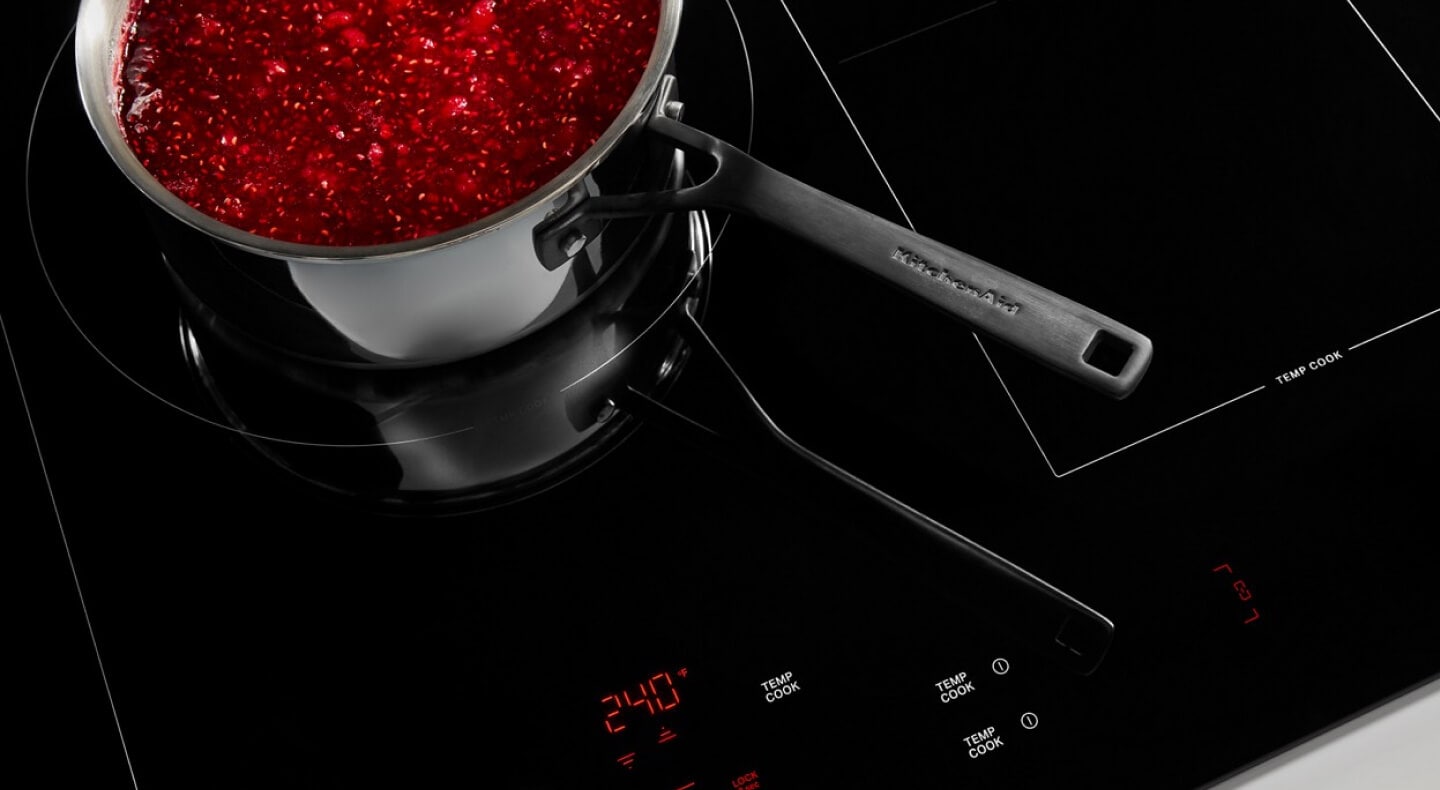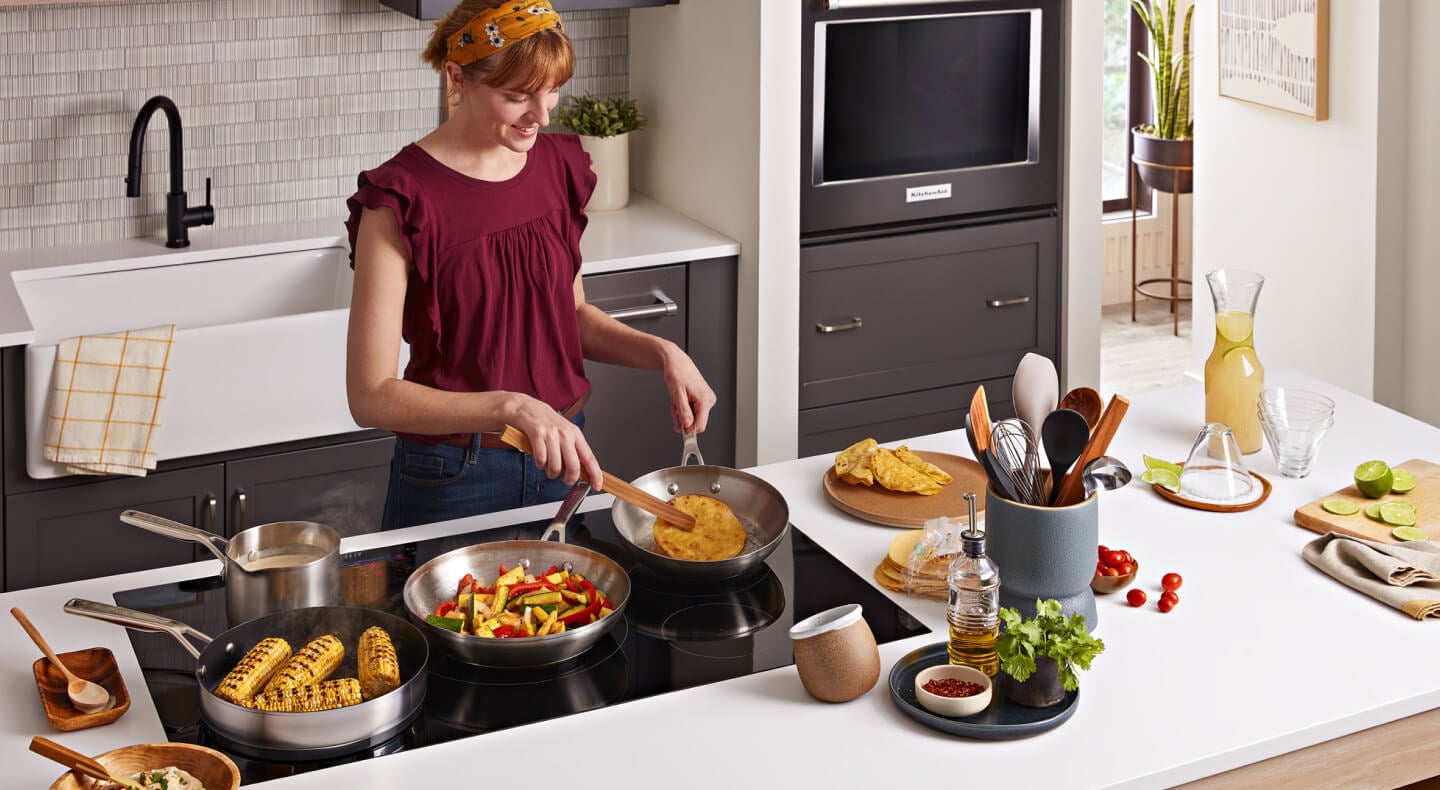
How to clean an induction cooktop in 5 easy steps
Induction cooktops can not only enhance your cooking techniques, but they can also elevate your kitchen style with smooth, sleek designs. When the surface gets messy, you can often quickly clean it with the right tools and tips.
Help keep your ceramic glass cooktop looking great and learn how to polish it without leaving scratches or stains with this guide.
What's the best way to clean an induction cooktop?
For strong results, it’s recommended to clean your ceramic glass cooktop shortly after using it and after it has cooled down. Cleaning your cooktop can take roughly 2 to 5 minutes with a cleaning solution and a damp cloth—though sometimes a deeper cleaning is needed. In these instances, a cleaning kit, scraper and nonabrasive pad can be used to clean your induction cooktop and have it ready for your next meal.
To help avoid damage to your cooktop, remember to refer to your owner’s manual and follow the directions on all cleaning products before using them.
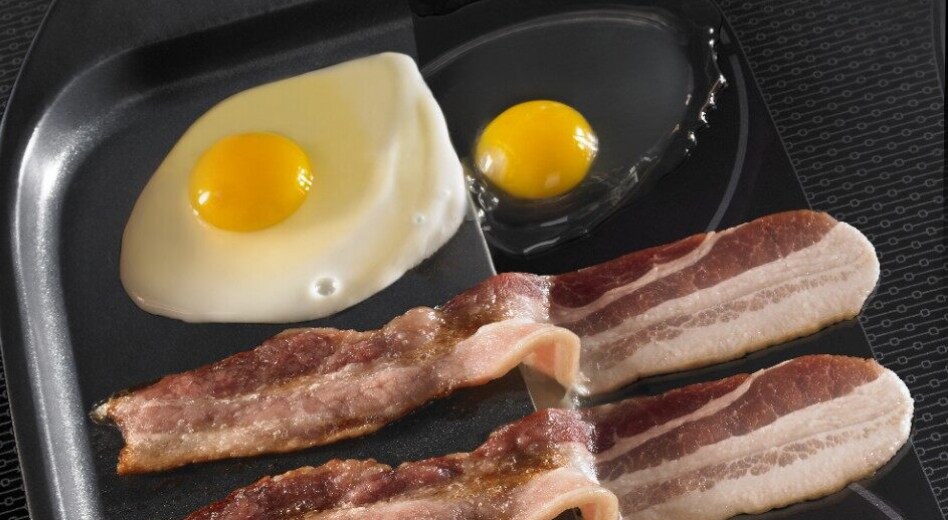

Induction stovetop cleaning instructions
Once you’re done cooking and loading up the dishwasher, likely the only thing possibly standing between you and a clean kitchen is your ceramic glass cooktop. Induction cooktops use electromagnetic energy to directly heat compatible cookware, so the cooktop surface cools off quickly and is generally easy to clean.
In fact, if spillage occurs with your homemade pasta sauce, the induction cooktop surface helps minimize the chances of burnt-on or charred messes. However, hard water stains and white marks may still occur. No matter the mess, the step-by-step instructions below can help you get your induction cooktop clean.
If you have an oven, check out these tips for cleaning a self-cleaning oven for an effective cleanup.
Supplies
- Cooktop cleaning solution
- Or, baking soda and vinegar
Tools
A cooktop scraper
Cooktop scrubbing pad
Cooktop cleaning wipes, soft cloth, sponge or nonabrasive pad
Oven mitt
For a more thorough approach, streak-free cooktop cleaners and nonabrasive cleaning kits can help tend to your induction cooktop surface without damaging it. KitchenAid brand also offers a Retractable Scraping Tool designed to help remove residue from your ceramic glass cooktop surface.
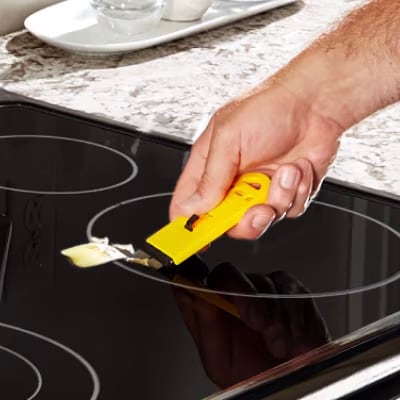
1. Scrape the cooktop surface
For burnt-on grease or residue, wait for the cooktop to cool down so it is warm, but not hot to the touch. Then, hold the scraper as flat as possible to loosen any residue without scratching the glass. Repeat the process as needed.
Note: Though induction cooktops do not radiate their own heat through the surface, hot cookware on top can still transfer heat. It’s still best to let it cool after you have removed the cookware and turned off the cooktop.
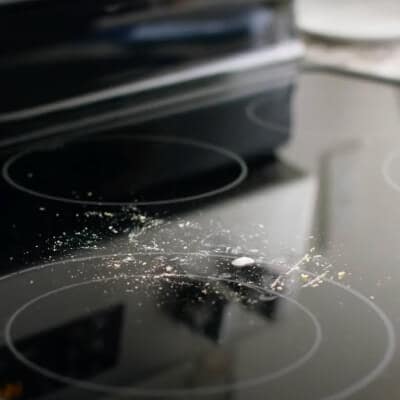
2. Spray the cooktop surface
Once your cooktop is completely cool to the touch, spray the surface with a cleaning solution or diluted vinegar mix. Let the solution rest for 10 to 15 minutes, and wipe the surface with a soft cloth or cleaning pad.
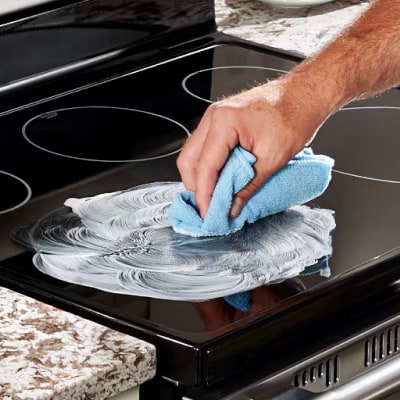
3. Apply glass and ceramic cleaner
Apply a dime-sized drop of a gentle yet powerful cooktop cleaning solution to any stubborn messes. Using a nonabrasive scrubbing pad, rub the affected areas until the residue is loosened. Let the cleaning solution settle to a hazy white film before moving to the next step.
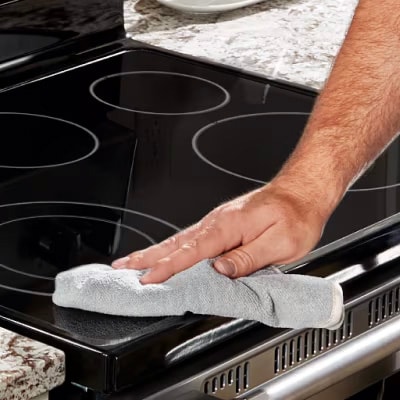
4. Polish the surface
Using a dry cloth, gently wipe and polish the cooktop surface. Continue rubbing until the white film disappears.
5. Repeat the cleaning process, if needed
After scraping, cleaning and polishing, sometimes stubborn messes still remain. If this is the case, simply repeat steps one through four until your cooktop surface is clean.
Scrape the cooktop surface.
Spray the cooktop surface with a diluted vinegar solution or cleaner, then wipe away.
Treat the surface with a trusted cooktop cleaner.
- Polish the cooktop.
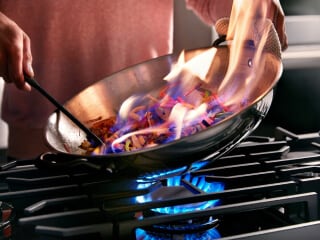
FIND THE RIGHT COOKTOP FOR YOU
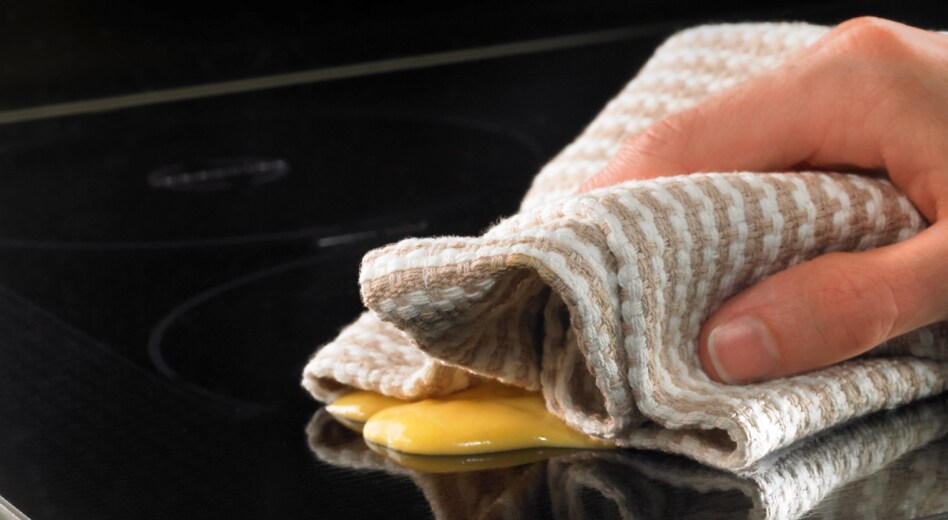

Induction cooktop care tips
For light or moderate messes, wait until the cooktop has cooled down and clean the surface with a damp sponge and cleaner.
- For heavy soil or stubborn residue, use a nonabrasive cleanser and scraper to help get rid of the mess.
- To help prevent scratches, avoid using abrasive cleaning agents, steel wool, hard water and hard scrubbing tools on your cooktop surface, as they can damage your cooktop.

KitchenAid® POWER BOOST FUNCTION
Get extra heat when you need it
Select KitchenAid® induction cooktops with the Power Boost Function let you ramp up the heat for short periods of time so you can start creating your favorite recipes faster
What to use to clean an induction cooktop
Soap, water, a soft cloth or sponge, and cooktop cleaners are generally all effective to use on your induction cooktop. In some cases, you could also apply a baking soda and vinegar mixture to burnt-on residues before using a cooktop scraper to help gently lift them away.
When understanding what to use to clean an induction cooktop, it’s important to always refer to your owner’s manual and the product’s instructions.
What not to use to clean an induction cooktop
To help prevent damage to your induction cooktop, avoid using the following products in your cleanup routine:
Steel wool
- Ferrous scrubbing brushes (brushes with steel bristles)
- Abrasive powder cleansers
Chlorine bleach
Rust removers
Ammonia
For best results, always refer to your owner’s manual and the instructions on your cleaning products before using them.
How to remove white marks or water stains from an induction cooktop
Remove white marks or hard water stains from your cooktop using vinegar. White marks on an induction cooktop can be caused by mineral deposits from food and water, and vinegar’s acidic nature helps break down these minerals.
Moisten a dry cloth with white vinegar and apply it to the stains.
Let the vinegar settle for a few minutes, then rub the stains away.
Rinse with a new clean cloth and cooktop cleaning solution or distilled water.
Dry the cooktop with a clean microfiber cloth.
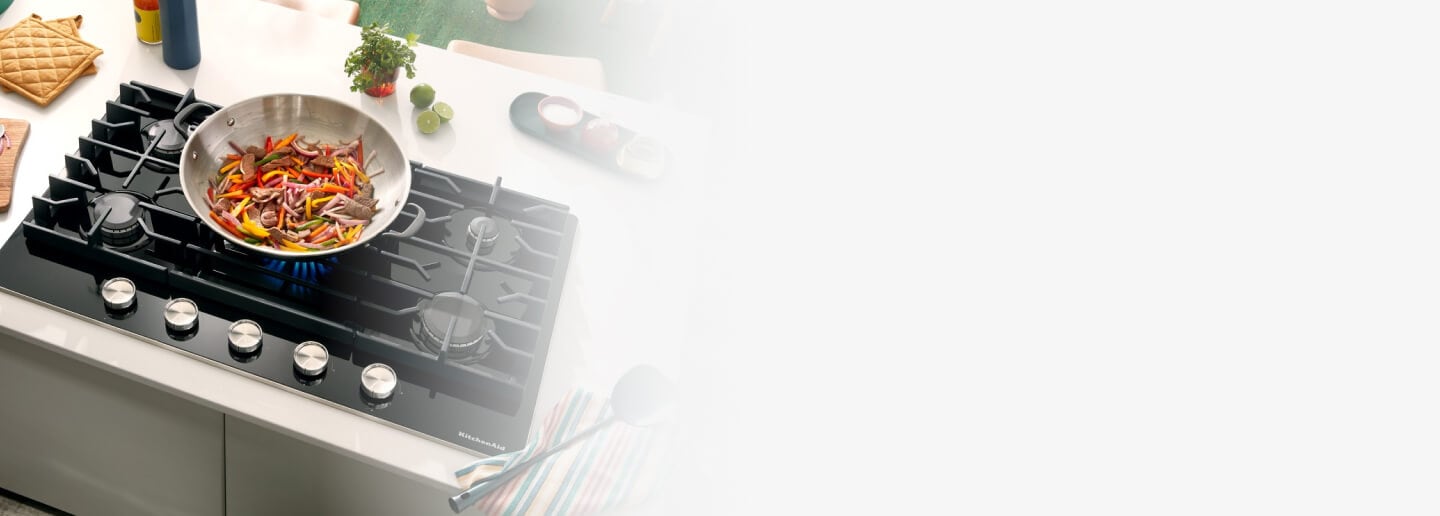
KitchenAid® cooktops
Cooktops made for every culinary adventure
KitchenAid® gas, electric and induction cooktops offer the versatility, performance and craftsmanship you need to create your favorite recipes

Destination: Design
Follow the path to inspiration
Join two creative storytellers as they travel to a unique destination, and watch as KitchenAid brand transforms their inspiration into stunning designs
